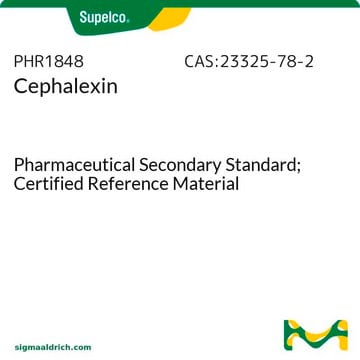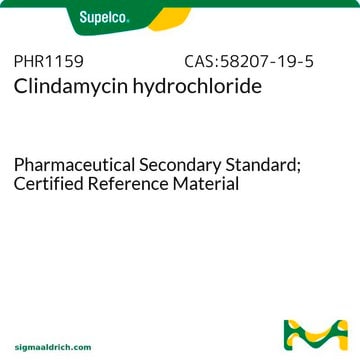F0756
Fusidinsäure
Synonym(e):
Ramycin
About This Item
Empfohlene Produkte
Lagertemp.
2-8°C
SMILES String
[H][C@@]12CC[C@@]3(C)[C@@]([H])([C@H](O)C[C@@]4([H])\C([C@H](C[C@]34C)OC(C)=O)=C(/CC\C=C(\C)C)C(O)=O)[C@@]1(C)CC[C@@H](O)[C@H]2C
InChI
1S/C31H48O6/c1-17(2)9-8-10-20(28(35)36)26-22-15-24(34)27-29(5)13-12-23(33)18(3)21(29)11-14-30(27,6)31(22,7)16-25(26)37-19(4)32/h9,18,21-25,27,33-34H,8,10-16H2,1-7H3,(H,35,36)/b26-20-/t18-,21-,22-,23+,24+,25-,27-,29-,30-,31-/m0/s1
InChIKey
IECPWNUMDGFDKC-MZJAQBGESA-N
Suchen Sie nach ähnlichen Produkten? Aufrufen Leitfaden zum Produktvergleich
Anwendung
- as a standard in thin-layer chromatography (TLC)-densitometric method
- to study its ability to bind to human serum albumin
- as an antibiotic in combination with tannic acid to determine minimum inhibitory concentrations (MIC) in methicillin-resistant Staphylococcus aureus (MRSA)
Biochem./physiol. Wirkung
Signalwort
Warning
H-Sätze
Gefahreneinstufungen
Acute Tox. 4 Oral
Lagerklassenschlüssel
11 - Combustible Solids
WGK
WGK 3
Flammpunkt (°F)
Not applicable
Flammpunkt (°C)
Not applicable
Persönliche Schutzausrüstung
dust mask type N95 (US), Eyeshields, Gloves
Analysenzertifikate (COA)
Suchen Sie nach Analysenzertifikate (COA), indem Sie die Lot-/Chargennummer des Produkts eingeben. Lot- und Chargennummern sind auf dem Produktetikett hinter den Wörtern ‘Lot’ oder ‘Batch’ (Lot oder Charge) zu finden.
Besitzen Sie dieses Produkt bereits?
In der Dokumentenbibliothek finden Sie die Dokumentation zu den Produkten, die Sie kürzlich erworben haben.
Kunden haben sich ebenfalls angesehen
Unser Team von Wissenschaftlern verfügt über Erfahrung in allen Forschungsbereichen einschließlich Life Science, Materialwissenschaften, chemischer Synthese, Chromatographie, Analytik und vielen mehr..
Setzen Sie sich mit dem technischen Dienst in Verbindung.













